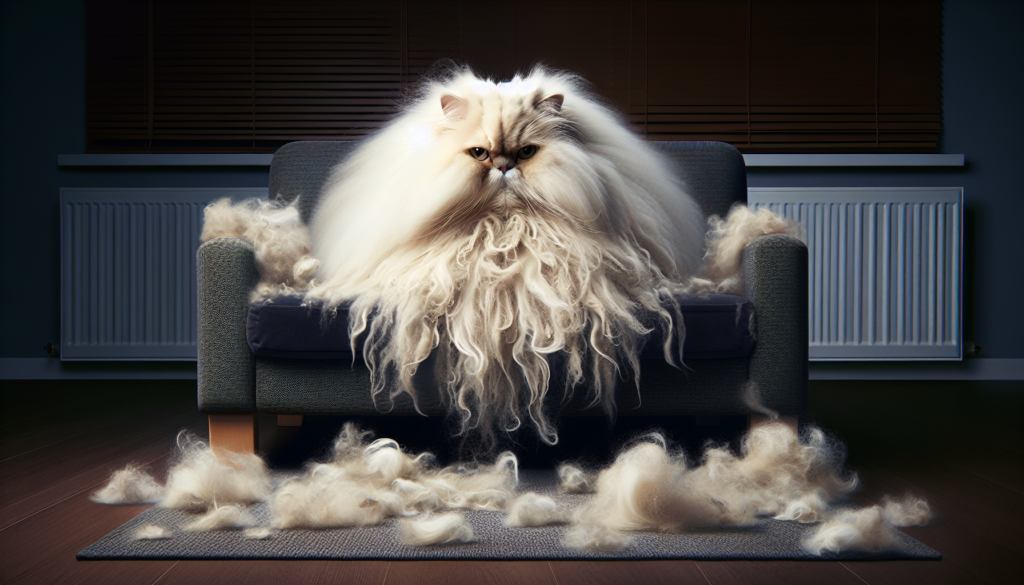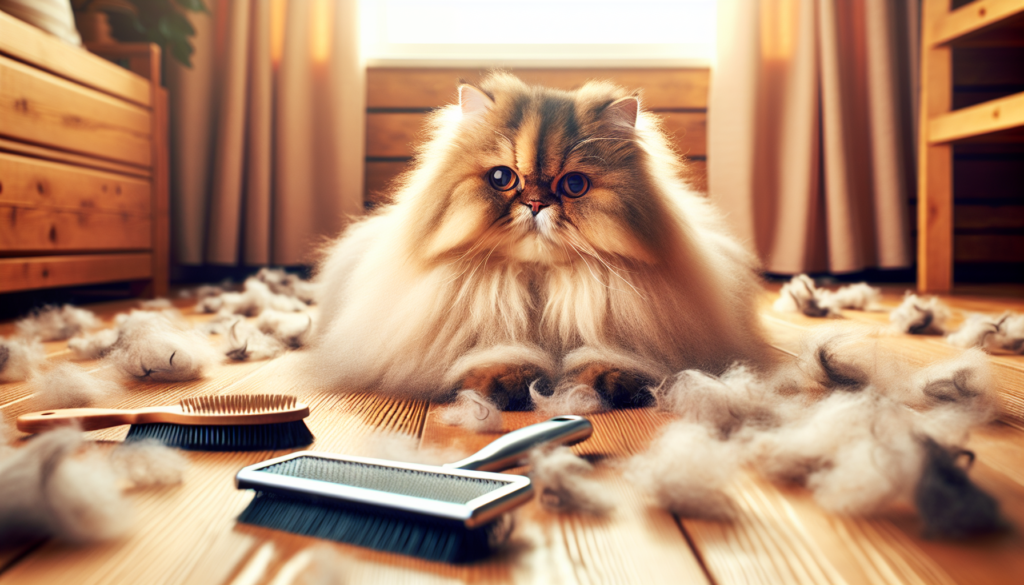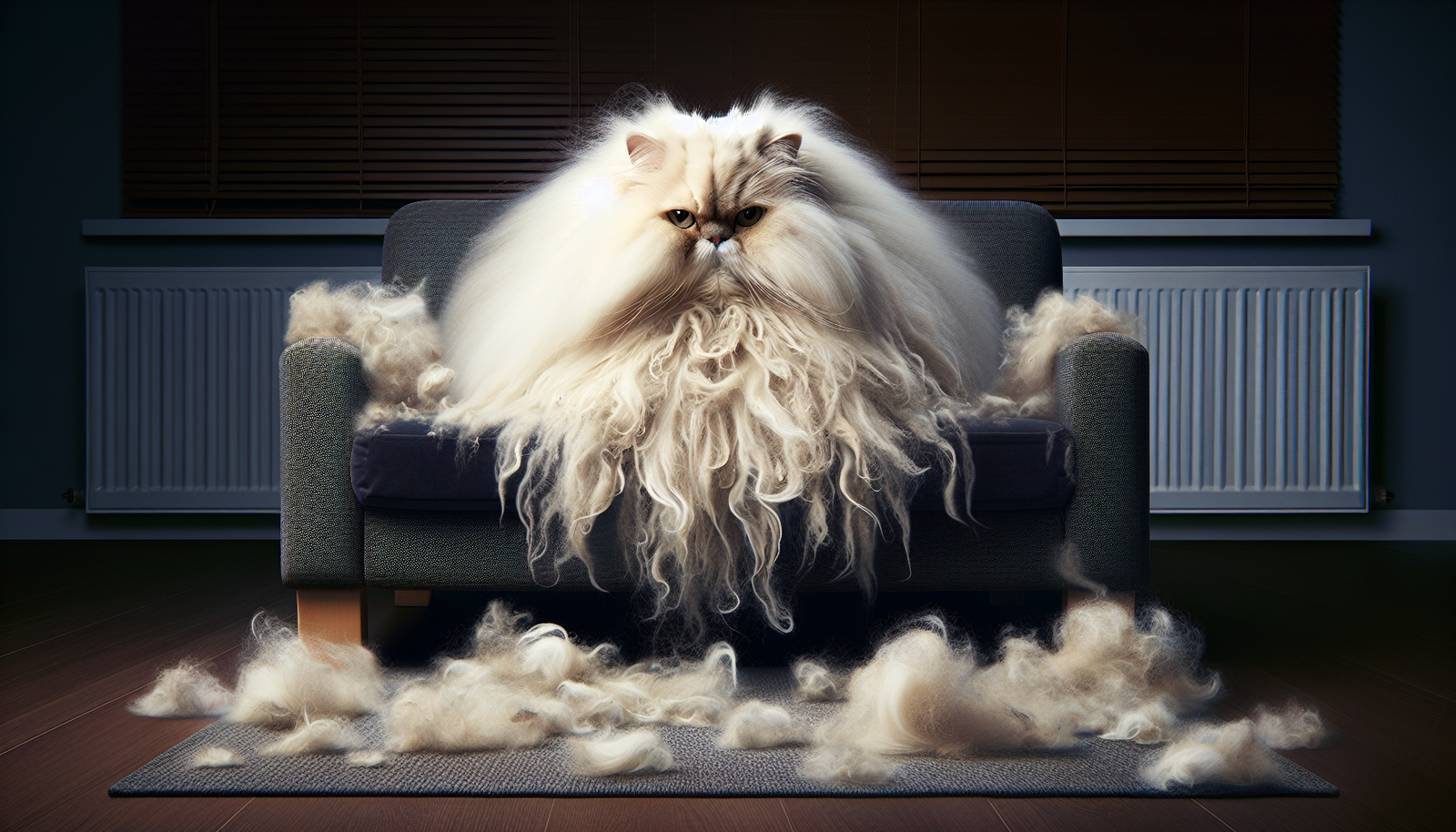Have you ever wondered why Persian cats are infamous for their excessive shedding? It’s no secret that these majestic felines are known for leaving trails of fur wherever they go. However, the reasons behind their shed-prone nature go beyond mere aesthetics. In this article, we will explore the factors that contribute to why Persian cats shed so much, shedding light on the topic and helping you better understand the needs of these regal creatures. So, grab a cup of tea and let’s embark on a hair-raising journey into the world of Persian cat shedding!
Why Persian Cats Are Known for Excessive Shedding
Persian cats are undeniably graceful and elegant creatures, known for their luxurious and voluminous coats. However, alongside their beauty comes a common concern among potential owners – the excessive shedding that Persian cats are renowned for. In this article, we will delve into the reasons behind this shedding issue, exploring their physical characteristics, genetic predisposition, environmental factors, and more. By gaining a deeper understanding of the shedding process in Persian cats, we can better equip ourselves to manage and maintain their beautiful coats.

Overview of Persian Cats
History and Origin
Persian cats have a long and rich history, dating back to ancient times. Originating in Persia (modern-day Iran), these feline companions were highly treasured by nobles and royals for their stunning appearance and pleasant personalities. Over time, Persian cats made their way into various parts of the world, and through careful breeding practices, they have become one of the most beloved and recognizable cat breeds.
Distinctive Features
What sets Persian cats apart from other breeds are their distinctive features. They possess large round eyes, a short snub nose, and a broad head. Their bodies are well-rounded and muscular, complemented by a thick, flowing coat that practically shrouds them in elegance. These features, while visually stunning, also contribute to their shedding tendencies.
Temperament and Personality
Persian cats are known for their calm and gentle nature. They are typically laid-back and enjoy a relaxed and comfortable lifestyle. They thrive on human companionship and make excellent indoor pets, as they are not particularly fond of outdoor adventures. Their docile temperament and low activity levels make them ideal for individuals looking for a serene and affectionate companion.
Popular Varieties of Persian Cats
Persian cats come in a variety of colors and patterns, offering a wide range of choices for prospective cat owners. Some popular varieties include the solid color Persian, shaded and smoke Persians, tabby Persians, and the exquisite Himalayan variety. Each variety possesses its own unique coat characteristics, which can influence shedding to varying degrees.
Popularity and Demand
Due to their striking appearance and gentle demeanor, Persian cats have gained immense popularity over the years. Their distinct features and regal charm have captivated the hearts of cat lovers worldwide, resulting in high demand for this breed. However, before bringing a Persian cat into your home, it is essential to understand and prepare for their shedding tendencies.
Understanding Shedding in Cats
Naturally Shedding Animals
Shedding is a natural process that occurs in many animals, including cats. Shedding enables cats to get rid of old and damaged hair, making way for the growth of new, healthy fur. It is a regular part of their growth cycle and should not be a cause for concern unless it becomes excessive.
Role of Shedding in Cats
Beyond the aesthetic aspect, shedding plays a vital role in a cat’s overall health. It helps to regulate body temperature, remove dead or damaged hair, and maintain the condition of their coats. Shedding can vary in frequency and intensity among different cat breeds, with Persian cats often experiencing a more pronounced shedding pattern.
Normal Shedding vs. Excessive Shedding
It is essential to differentiate between normal shedding and excessive shedding when it comes to Persian cats. Normal shedding involves the gradual release of hair throughout the year, resulting in a reasonable amount of loose fur. Excessive shedding, on the other hand, refers to a significantly higher volume of hair loss, which can be a cause for concern. Persian cats are known to shed more than other breeds, and understanding the factors that contribute to this shedding can help us manage it effectively.
Factors Influencing Shedding
Seasonal Changes
One factor that influences shedding in Persian cats is seasonal changes. As the seasons transition from warmer to colder months, or vice versa, a cat’s shedding pattern may change. In preparation for cold weather, Persian cats tend to shed their lighter summer coat to make way for a thicker, insulating winter coat. This shedding is typically more noticeable and can contribute to the perception of excessive shedding.
Hormonal Influences
Hormonal changes can also impact a cat’s shedding patterns. Female Persian cats, in particular, experience hormonal fluctuations during their estrus or heat cycle, which can trigger additional shedding. Male Persian cats may also experience hormonal variations, although to a lesser degree. These hormonal influences can contribute to fluctuations in shedding levels throughout the year.
Age and Life Cycle
Another factor that contributes to shedding in Persian cats is their age and life cycle. Kittens have a different growth cycle than adult cats, which can result in shedding during their transition to adulthood. As they mature, their coat undergoes changes, and shedding may vary in frequency and intensity. Similarly, older Persian cats may experience increased shedding as their coat quality changes with age.
Stress and Anxiety
Stress and anxiety can have a significant impact on a cat’s overall health, including their shedding patterns. Persian cats, known for their sensitive nature, may be more prone to stress-related shedding. Changes in the environment, such as moving to a new home or the presence of unfamiliar people or pets, can trigger stress and potentially lead to excessive shedding. Creating a calm and stress-free environment for your Persian cat can help alleviate shedding caused by anxiety.
Physical Characteristics that Contribute to Shedding
Hair Structure and Growth Cycle
The long, silky fur of Persian cats is a defining physical characteristic that contributes to their shedding. Their hair structure, with a dense, cotton-like undercoat, makes their fur prone to matting and tangling. The growth cycle of their hair is also different from other breeds, resulting in a more frequent and apparent shedding pattern.
Presence of Dander
Dander, tiny particles of dead skin shed by animals, can exacerbate shedding issues in Persian cats. Dander can stick to their fur and become airborne, causing allergies and respiratory problems in susceptible individuals. The presence of dander can also contribute to the perception of excessive shedding, even if the actual hair loss is not abnormal.
Skin Condition and Health
The condition of a cat’s skin plays a crucial role in shedding. Persian cats, while known for their beautiful fur, are prone to skin conditions, such as dryness or excessive oiliness. These conditions can impact their shedding patterns, with dry skin potentially leading to increased shedding and oiliness contributing to matting and tangling.

Long, Thick Coat
Evolutionary Adaptation
The long, thick coat of Persian cats is an evolutionary adaptation that originated in their native land. The Persian cat’s ancestors developed this dense coat to withstand the harsh climates of the Iranian plateau, providing insulation and protection from extreme temperatures.
Insulation and Protection
The primary purpose of the Persian cat’s long coat is to provide insulation and protection against the elements. The dense fur helps regulate body temperature, keeping them warm in cooler climates and providing a barrier against the scorching sun. However, this luxurious coat also means an abundance of hair to shed.
Increased Hair Volume and Shedding
The evolutionary adaptation of a long, thick coat in Persian cats results in increased hair volume, which, in turn, contributes to shedding. Persian cats have a higher number of hair follicles compared to other cat breeds, meaning there is simply more hair to be shed. The voluminous nature of their coat leads to a more noticeable shedding process.
Hair Length and Shedding Frequency
Difference Between Short-Haired and Long-Haired Cats
The length of a cat’s hair can significantly impact shedding frequency. Short-haired cats, with their sleek and less voluminous coats, tend to shed less compared to long-haired breeds like Persian cats. The longer the hair, the more prone it is to shedding, as it reaches a certain length and enters the shedding phase of the growth cycle.
Effect on Shedding Frequency
Persian cats, with their long and dense fur, shed more frequently than their short-haired counterparts. The shedding frequency can vary among individual Persian cats, with some experiencing more pronounced shedding seasons than others. However, it is important to note that shedding in Persian cats is a natural process, albeit more noticeable, and can be managed effectively with proper care and grooming.
Managing Shedding in Long-Haired Cats
To combat excessive shedding in Persian cats, regular grooming is crucial. Daily brushing helps prevent matting, tangling, and the buildup of loose hair. It also helps distribute the naturally occurring oils on their skin, keeping their coat healthy and reducing shedding. Additionally, providing a proper diet, rich in essential nutrients, can contribute to overall coat health and reduce shedding.
Lack of an Undercoat
Understanding the Undercoat
The undercoat is a layer of short, fluffy hairs found beneath the outer coat of a cat. It serves as additional insulation and helps regulate body temperature. Many cats, particularly those from colder climates or with double coats, possess a well-developed undercoat.
Persian Cats and Absence of Undercoat
Unlike some other long-haired breeds, Persian cats lack a well-defined undercoat. Their fur consists mainly of the long, silky guard hairs that make up the outer coat. Without the presence of a substantial undercoat, Persian cats shed more noticeably, as there is less hair to support the shedding process.
Impact on Shedding Levels
The absence of an undercoat in Persian cats contributes to their shedding levels. The long, dense guard hairs are more prone to tangling and matting, resulting in a higher volume of hair loss. Additionally, the lack of an undercoat means that the shedding is more apparent, with individual hairs falling out more easily.
Genetic Predisposition to Shedding
Inheritance of Shedding Traits
Genetics play a significant role in a cat’s shedding tendencies, and Persian cats are no exception. Certain genetic traits can make them more prone to shedding, with some bloodlines passing down a higher shedding propensity to their offspring. However, it is important to note that not all Persian cats within the same bloodline will necessarily shed the same amount.
Specific Breeding Practices
Breeding practices can also influence shedding levels in Persian cats. Breeders who focus on maintaining the breed’s desirable physical characteristics, such as the long, luxurious coat, may inadvertently contribute to higher shedding tendencies. Intense selective breeding for specific traits can sometimes lead to unintended consequences, including an increase in shedding.
Variations Among Persian Cat Lines
It is worth noting that shedding levels can vary among different Persian cat lines. While the breed as a whole is known for excessive shedding, individual lines or breeding programs may have more success in minimizing shedding tendencies. Consulting with reputable breeders and discussing the shedding history within their bloodlines can provide valuable insights when choosing a Persian cat.
Health Issues and Shedding
Skin Conditions
Skin conditions can contribute to increased shedding in Persian cats. Dry skin, seborrhea, and dermatitis are common issues that can affect their overall coat health and lead to excessive hair loss. Regular veterinary check-ups and proper skin care can help identify and address any underlying skin issues, ultimately reducing shedding.
Allergies
Persian cats, due to their long hair and dander production, can trigger allergies in susceptible individuals. Allergic reactions can manifest in various ways, including skin irritation and respiratory symptoms. While shedding itself is not an allergic reaction, the presence of loose fur can exacerbate allergies for those sensitive to cat dander.
Parasites
Parasites, such as fleas or mites, can cause itching, discomfort, and increased shedding in Persian cats. Regular parasite prevention measures, including topical treatments and regular grooming, can help minimize the risk of infestations and reduce shedding caused by these pesky critters.
Diet and Nutrition
A cat’s diet and nutrition play a vital role in their overall health and coat condition. Nutrient deficiencies or imbalances can impact the quality of their fur and contribute to shedding. Ensuring that Persian cats receive a well-balanced and nutritious diet, specifically formulated for their needs, can help reduce shedding caused by poor coat health.
In conclusion, the shedding experienced by Persian cats is a combination of various factors, including their physical characteristics, genetic predisposition, environment, and overall health. While excessive shedding may be a concern for some potential owners, armed with knowledge and proper care practices, these beautiful feline companions can still thrive in loving homes. Regular grooming, a balanced diet, and a stress-free environment can all contribute to managing shedding and ensuring that the Persian cat’s luxurious coat remains a source of pride and joy.

